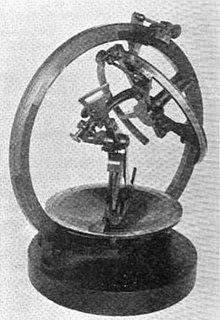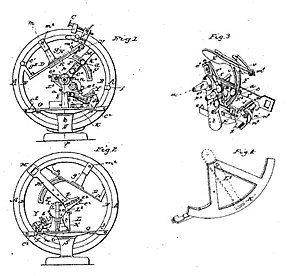Equatorial sextant
The Equatorial Sextant was made by William Austin Burt. The purpose of this type of sextant was to get an accurate position of a ship at sea.[1][2] Burt applied the principles of his earlier solar compass invention to this new navigational instrument.

History
William Austin Burt exhibited his prior invention of the solar compass at the Great Exhibition Crystal Palace in the 1851 London's World Fair.[3] In the return trip to Philadelphia from Europe Burt intentionally took back to America a slower sailing vessel that took six weeks time.[4] He wanted to observe what happened out at sea and took notes on this longer ocean trip. He wanted to apply the technology of his Solar Compass invention to make a guide for sailors at sea, like he had done for surveyors in the wilderness. Burt noticed on this six week trip that the captain was misguided by the ship's compass, which caused the ship to go off course several times delaying the arrival. He applied his findings and experiments of this return trip to his Solar Compass with the idea to help navigation become easier and more accurate.[5] The resulting instrument he devised called the equatorial sextant lived up to his expectations of being as useful to ship captains as his solar compass was to the surveyor.[6]
Shortly after he had designed his Equatorial Sextant he retired as a surveyor to devote his time to teaching the use of this special navigational instrument. He moved to Detroit for this purpose. Burt & Bailey company of Detroit built his first prototype by the early part of 1855. Burt had obtained an accurate reading within five degrees on board the ship Illinois on its historic first journey through the Soo Canal on June 18, 1855.[7] In March 1856 Burt sent a sample of one of his Equatorial Sextants to the Navy Department. He sent another sample to the U.S. Coast Guard. They both agreed that Burt's Equatorial Sextant met the purpose of its design. His precision instrument was then finalized and approved on patent No. 16,002 in the United States and officially recorded on November 4, 1856.[8][9] He envisioned a greater worldwide potential for his nautical instrument than for that of his surveying instrument of the Solar Compass.[10] Burt instructed lake captains in the use of this new sextant and gave them classes in astronomy and navigation. The captains learned valuable knowledge taught from "old salts" and they were able to make successful winter trips across the Atlantic with just their lake schooners. Burt died, however, two years after he patented the Equatorial Sextant and he was not able to perfect his new navigational aid.[11]
Description

Burt made the first equatorial sextant.[12] It was patented in the United States in 1856 as number 16,002 and followed by 1857 patents in England, France and Belgium. His instrument eliminated the dependency upon a nautical chart to figure out a ship's position at sea.[13] His instrument was used to take azimuths, latitude, and hour angle at any time of day with one observation when properly manipulated.[4][14]
Burt's sextant had two principal rings. The inner latitude ring could rotate 90 degrees inside the outer meridian ring. An azimuth ring was attached to the meridian ring. A ship's bearing was determined by settings of the astronomical triangle consisting of declination, latitude, altitude, hour angle, and azimuth. Three of these were used. The main purpose of Burt's new instrument was to determine the variation of the needle in the magnetic compass for a more accurate reading of a ship's position at sea. Its principles of operation came from the basics of the mechanics of Burt's solar compass invention patented some twenty years earlier.[7]
Burt claimed in his patent that he took the common sextant and combined it with his special mechanical techniques of horizontal and equatorial movement settings to obtain latitude, time, azimuth, altitude and declination without having to figure it out mathematically as they were read directly off the instrument. Many problems in nautical astronomy are solved at once with the use of the Equatorial Sextant. It has the capability of reading off the latitude, hour angle, and azimuth without computation thereby eliminating mathematical errors. It can do these readings any time of the day. It is a combination of the reflecting sextant with meridian, azimuth, and hour circles. It is designed to give immediately the azimuth and hour angle by observation of the altitudes of the heavenly bodies. The corresponding angles are read off on the respective circles, thereby giving the position of a ship at sea at once with the use of a marine chronometer.[9]
Legacy
The University of Michigan received Burt's original 1858 Equatorial Sextant from his heirs in 1909 as an heirloom to navigation and engineering. It came with a pamphlet of Instructions on how to use it which was written by the inventor. The reason it was given to the college is because the university specializes in Navigation and Engineering study courses.[15]
References
- "Smithsonian - Equatorial Sextant". Archived from the original on 2011-06-29. Retrieved 2010-11-10.
- "The life and times of William A. Burt". Archived from the original on 2011-07-15. Retrieved 2010-11-07.
- Lamphier 2019, p. 225.
- Peters, Gary (October 24, 1979). "World's First Writing Machine". The Sheboygan Press. Sheboygan, Wisconsin. p. 47 – via Newspapers.com

- Peters, Gary (November 26, 1981). "Burt known across ocean". Lansing State Journal. Lansing, Michigan. p. 30 – via Newspapers.com

- Mitts, Dorothy (April 5, 1964). "Typewriter Inventor Pioneered Here". The Times. Port Huron, Michigan. p. 8 – via Newspapers.com

- Burt 1986, p. 129.
- "List of Patents". TEvening Star. Washington, District of Columbia. November 6, 1856. p. 2 – via Newspapers.com

- United States Letters Patent No. 16,002 (Nov. 4, 1856) - Equatorial Sextant
- Burt 1986, p. 130.
- Tuttle 1873, p. 523.
- "Charles S. Burt". Mining and Metallurgy. September (177): 42. 1921. Retrieved July 8, 2020.
- Lamphier 2019, p. 226.
- Cox, John A. (August 9, 1953). "Patron Saint of Stenographers". Hartford Courant. Hartford, Connecticut. p. 112 – via Newspapers.com

- "Equatorial Sextant". The Michigan Technic. 29: 200–201. 1916. Retrieved June 11, 2020.
Sources
- Lamphier, Peg A. (2019). Technical Innovation in American History. ABC-CLIO. ISBN 978-1610-69094-2.
- Burt, John A. (1986). William Austin Burt and sons, surveyors of public domain. Landmark Enterprises. ISBN 978-0910-84531-1.
- Tuttle, Charles Richard (1873). General History of Michigan with biographical sketches. R. D. S. Tyler & Company. OCLC 646929780.